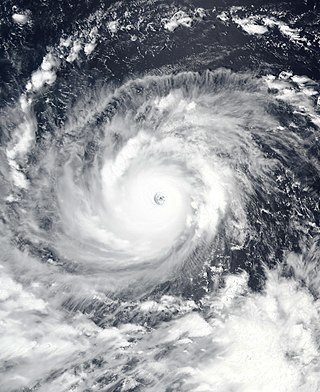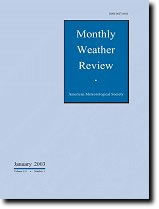
Meteorology is a branch of the atmospheric sciences with a major focus on weather forecasting. The study of meteorology dates back millennia, though significant progress in meteorology did not begin until the 18th century. The 19th century saw modest progress in the field after weather observation networks were formed across broad regions. Prior attempts at prediction of weather depended on historical data. It was not until after the elucidation of the laws of physics, and more particularly in the latter half of the 20th century the development of the computer that significant breakthroughs in weather forecasting were achieved. An important branch of weather forecasting is marine weather forecasting as it relates to maritime and coastal safety, in which weather effects also include atmospheric interactions with large bodies of water.

The World Meteorological Organization (WMO) is a specialized agency of the United Nations responsible for promoting international cooperation on atmospheric science, climatology, hydrology and geophysics.

La Niña is an oceanic and atmospheric phenomenon that is the colder counterpart of El Niño, as part of the broader El Niño–Southern Oscillation (ENSO) climate pattern. The name La Niña originates from Spanish for "the girl", by analogy to El Niño, meaning "the boy". In the past, it was also called an anti-El Niño and El Viejo, meaning "the old man."

The National Hurricane Center (NHC) is the division of the United States' NOAA/National Weather Service responsible for tracking and predicting tropical weather systems between the Prime Meridian and the 140th meridian west poleward to the 30th parallel north in the northeast Pacific Ocean and the 31st parallel north in the northern Atlantic Ocean. The agency, which is co-located with the Miami branch of the National Weather Service, is situated on the campus of Florida International University in Westchester, Florida.

In meteorology, a low-pressure area, low area or low is a region where the atmospheric pressure is lower than that of surrounding locations. Low-pressure areas are commonly associated with inclement weather, while high-pressure areas are associated with lighter winds and clear skies. Winds circle anti-clockwise around lows in the northern hemisphere, and clockwise in the southern hemisphere, due to opposing Coriolis forces. Low-pressure systems form under areas of wind divergence that occur in the upper levels of the atmosphere (aloft). The formation process of a low-pressure area is known as cyclogenesis. In meteorology, atmospheric divergence aloft occurs in two kinds of places:

The American Meteorological Society (AMS) is the premier scientific and professional organization in the United States promoting and disseminating information about the atmospheric, oceanic, and hydrologic sciences. Its mission is to advance the atmospheric and related sciences, technologies, applications, and services for the benefit of society.

A typhoon is a mature tropical cyclone that develops between 180° and 100°E in the Northern Hemisphere. This region is referred to as the Northwestern Pacific Basin, accounting for almost one-third of the world's annual tropical cyclones. A similar term, hurricane, is referred to mature tropical cyclone in the northeast Pacific and northern Atlantic. For organizational purposes, the northern Pacific Ocean is divided into three regions: the eastern, central, and western. The Regional Specialized Meteorological Center (RSMC) for tropical cyclone forecasts is in Japan, with other tropical cyclone warning centers for the northwest Pacific in Hawaii, the Philippines, and Hong Kong. Although the RSMC names each system, the main name list itself is coordinated among 18 countries that have territories threatened by typhoons each year.

The Monthly Weather Review is a peer-reviewed scientific journal published by the American Meteorological Society. It covers research related to analysis and prediction of observed and modeled circulations of the atmosphere, including technique development, data assimilation, model validation, and relevant case studies. This includes papers on numerical techniques and data assimilation techniques that apply to the atmosphere and/or ocean environment. The editor-in-chief is David M. Schultz.

A tropical cyclone is a rapidly rotating storm system characterized by a low-pressure center, a closed low-level atmospheric circulation, strong winds, and a spiral arrangement of thunderstorms that produce heavy rain and squalls. Depending on its location and strength, a tropical cyclone is referred to by different names, including hurricane, typhoon, tropical storm, cyclonic storm, tropical depression, or simply cyclone. A hurricane is a strong tropical cyclone that occurs in the Atlantic Ocean or northeastern Pacific Ocean, and a typhoon occurs in the northwestern Pacific Ocean. In the Indian Ocean, South Pacific, or (rarely) South Atlantic, comparable storms are referred to as "tropical cyclones", and such storms in the Indian Ocean can also be called "severe cyclonic storms".

The University of Hawaiʻi Press is a university press that is part of the University of Hawaiʻi.

Climate Dynamics is a peer-reviewed scientific journal published by Springer Science+Business Media. It covers all aspects of the dynamics of global climate systems, including analytical and numerical modeling research on the structure and behavior of the atmosphere, oceans, cryosphere, biomass, and land surface as interacting components of the dynamics of global climate. The journal also publishes reviews and papers emphasizing an integrated view of the physical and biogeochemical processes governing climate and climate change.

Jagadish Shukla is an Indian meteorologist and Distinguished University Professor at George Mason University in the United States.

The Meteorologische Zeitschrift is a bimonthly international peer-reviewed open access scientific journal covering research in meteorology and climatology. All papers published since 2000 are in English language. The journal was established in 1866 by the Österreichische Gesellschaft für Meteorologie and is one of the oldest journals in the field. In 1884 a similar journal was established by the Deutsche Meteorologische Gesellschaft. The two journals merged in 1886 and existed until 1944. After being published separately in East and West Germany after 1945, the journal was reestablished in 1992 as a joint publication of the Austrian, Swiss, and German Meteorological Societies and is published by Borntraeger Science Publishers.
Theoretical and Applied Climatology is a monthly journal published by Springer Science+Business Media which focuses on atmospheric sciences and climatology. It was established in 1949 as Archives for Meteorology, Geophysics and Bioclimatology, Series B and obtained its current name in 1986. It is published by Springer Science+Business Media and the editor-in-chief is Hartmut Graßl. According to the Journal Citation Reports, the journal has a 2020 impact factor of 3.179.
The Quarterly Journal of the Royal Meteorological Society is a peer-reviewed scientific journal of meteorology published eight times per year. It was established in 1871 as Bibliography of Meteorological Literature, obtaining its current name in 1873. It is published by Wiley-Blackwell on behalf of the Royal Meteorological Society.
Meteorological Applications is a peer-reviewed scientific journal of meteorology published four times per year since 1994. It is published by John Wiley & Sons on behalf of the Royal Meteorological Society.
Atmospheric Science Letters is a monthly peer-reviewed open access scientific journal covering the atmospheric sciences. It was established in 2000 and is published by John Wiley & Sons on behalf of the Royal Meteorological Society, of which it is the official journal. The editor-in-chief are Rebecca Hemingway and Andrea Montani. According to the Journal Citation Reports, the journal has a 2020 impact factor of 2.415, ranking it 57th out of 94 journals in the category "Meteorology & Atmospheric Sciences". Paul Hardaker is the founding editor.

During 2014, tropical cyclones formed within seven different tropical cyclone basins, located within various parts of the Atlantic, Pacific and Indian Oceans. During the year, a total of 117 tropical cyclones had formed this year to date. 79 tropical cyclones had been named by either a Regional Specialized Meteorological Center (RSMC) or a Tropical Cyclone Warning Center (TCWC). The most active basin in 2014 was the Western Pacific, which documented 23 named systems, while the Eastern Pacific, despite only amounting to 22 named systems, was its basin's most active since 1992. Conversely, both the North Atlantic hurricane and North Indian Ocean cyclone seasons experienced the fewest cyclones reaching tropical storm intensity in recorded history, numbering 9 and 3, respectively. Activity across the southern hemisphere's three basins—South-West Indian, Australian, and South Pacific—was spread evenly, with each region recording seven named storms apiece. So far, 26 Category 3 tropical cyclones formed, including ten Category 5 tropical cyclones in the year, becoming as the third-most intense tropical cyclone activity on record, only behind with 1997 and 2018.

During 2003, tropical cyclones formed within seven different tropical cyclone basins, located within various parts of the Atlantic, Pacific and Indian Oceans. During the year, a total of 129 systems formed with 85 of these developing further and were named by the responsible warning centre. The strongest tropical cyclone of the year was Cyclone Inigo, which was estimated to have a minimum barometric pressure of 900 hPa (26.58 inHg) and was tied with Cyclone Gwenda for being the most intense recorded cyclone in the Australian region in terms of pressure, with the possible exception of Cyclone Mahina. So far, 26 Category 3 tropical cyclones formed, including six Category 5 tropical cyclones formed in 2003, tying 2021.














